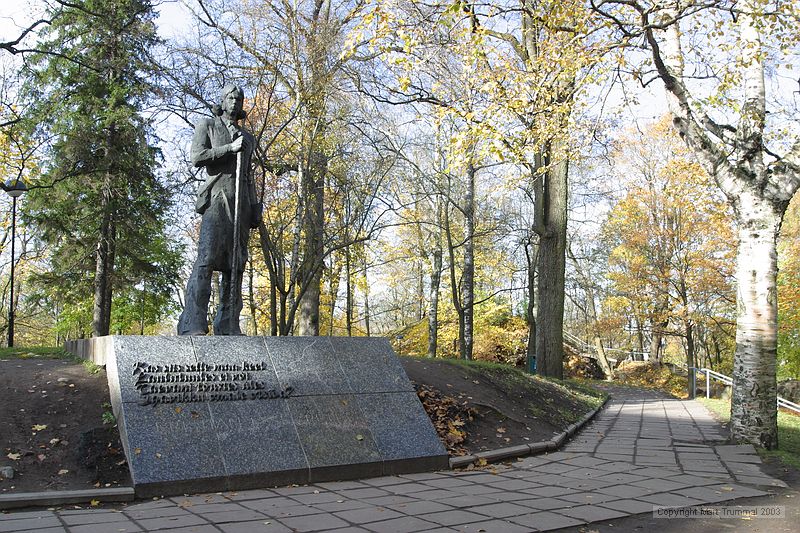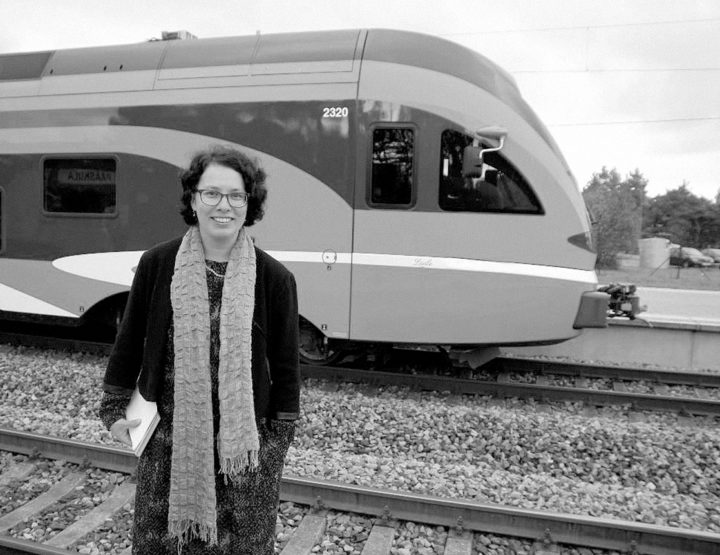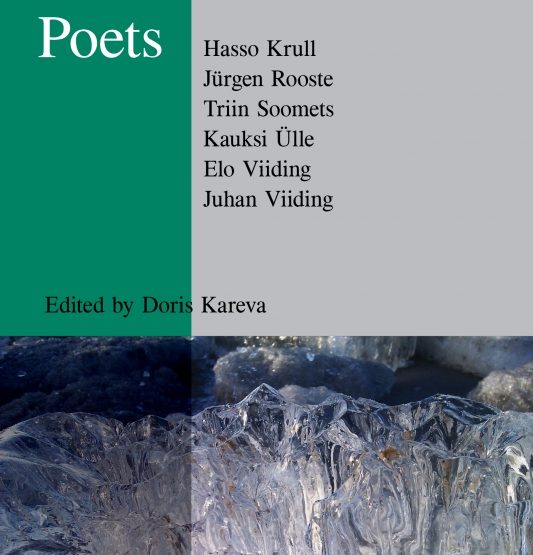The beginning of written poetry
The pre-Romantic Kristian Jaak Peterson (14 March 1801 – 4 August 1822) who burst upon the literary scene like a comet, is usually regarded as the founder of Estonian written poetry, which had moved away from the old folk song. This is an attractive although not the most fitting characterisation. Firstly, his forgotten manuscripts were brought into the limelight by the poet Gustav Suits only in the early 20th century, and thus they hardly had any impact before that. Secondly, the Baroque blossoms of Estonian-language written poetry had already been cultivated by the Estophile Lasnamäe lamburid (Lasnamäe Shepherds) Reiner Brockmann, Martin Giläus, Heinrich Göseken and Georg Salemann in the middle of the 17th century. In the next century, the fruits of their efforts were picked by Käsu Hans, Joachim Gottlieb Schwabe, Count von Mannteuffel, Gustav Adolph Oldekop and others, as well as by Peterson’s contemporaries, Reinhold Johann Winkler and Otto Wilhelm Masing.
The decisive factor in determining the First Poet was probably the idea of ‘pure’ nationality, although Peterson was more a Baltic German man of letters who was clad in the black coat of the ‘Mulks’ (inhabitants of southern Estonia) only a century later.
Genius
In terms of being an eruptive talent, no-one of the same era, except Johann Wolfgang von Goethe or Aleksandr Sergejevitch Pushkin, can really be compared with Peterson. As a true representative of Classicism, although with sentimental attributes of Romanticism, Peterson is an amazing and singular phenomenon in Estonian literature. One cannot help marvelling at the deeply philosophical and classical education that the German professors, having fled Napoleon, provided at Riga Regional Gymnasium. In addition, the talented young man had really nothing much to learn at Tartu University, especially as his favourite lecturer, theologian Wilhelm Friedrich Hezel was forced to leave due to the gradual Russification of the university. Should he have taken up Arabian numismatics? His path was supposed to continue in Germany, but was interrupted because of severe lung disease and his subsequent tragic death at an early age.
Diary
Peterson’ diary is the first truly philosophical Estonian work. Followingthe example of the dualist philosophy (Mikhail Lomonossov was influenced by it as well) of Christian Wolff who popularised Gottfried Wilhelm von Leibniz, Peterson reduced the world to two independent principles: the eternal spirit, God, and the eternal substance, mother-substance or matter, to which the mind gives life and organises. Divine goodness is the cause of everything, fertilises and attracts man’s mind, leading it towards freedom, bliss, wisdom and industry, away from earthly passions and commitment, to a lofty spiritual peace. Man must follow this calling. Fellow human beings are friends who must be supported; in order to free the body from slavery, the mind has to be enslaved, obeying the orders of the reason, in which lies true freedom. The biggest slave of all is God – a slave to himself, His perfect wisdom. The love of God makes people love one another as well, because their minds come from God.
Peterson’s rational deism contained antique cynicism and stoicism. Just like the cosmopolitan Diogenes, who lived in a barrel, Peterson, too, stifled desires, behaved and dressed with defiance and sought, “lantern in hand”, a friend, the Human Being who could be loved for his mind. The yearning for intellectual love is reflected in the poetic figure of Alo, who probably was at least partly based on an actual person, a young exuberant idealist. And not a homosexual, as some interpreters, without considering the whole intellectual system, have thought.
Missionary
Peterson expressed a wish to become a missionary. Hence constant language studies for which young Peterson was superbly gifted – he knew Hebrew, Greek, Latin, French, English, Russian, Swedish and probably also Latvian, to say nothing of German and Estonian. He was fascinated by American Indian, Asian and African languages. Hence his somewhat surprising theological studies – disseminating classical Christian truth to the aborigines, i.e. the Estonians!
It was his missionary aspirations that evoked his Romantic attitude to the language and enlightenment of the country people. This was, on the whole, a general philosophical urge, containing very little national ideology, which was later greatly amplified. Development in the manner of Friedrich Robert Faehlmann and Friedrich Reinhold Kreutzwald towards a later more obvious nationality is of course undeniable, but there was as yet no conscious opposition to the Baltic-German mentality. Besides, this would have been impossible, as the Baltic German intellectuals were his enthusiastic supporters. The diary’s laments about the truth “in a peasant’s coat”, which hindered friendship, did not express concerns regarding nationalism, but rather financial difficulties and social standing. The Awakening period with its festivities, in which Estonians sang themselves into a nation, was yet to come. Mentally, the young man of letters was thus more an Estophile than an “Estonian” in its later meaning. His linguistic efforts and his translation from Swedish of Christian Ganander’s Mythologia Fennica naturally appeared in German, as did the last poems posthumously published in Leipzig.
It is interesting that Estonian was not his mother’s, but instead his father’s tongue. Literary scholars do not think that Anna Elisabet Mikhailovna, the Catholic wife with a Russian-sounding name of the Riga assistant pastor Kikka Jaak, was an Estonian. It has been assumed that his mother, who came from common people, could have been Latvian, Livonian or some other nationality. Such families have given Estonian culture other poetic and linguistic talents: August Gailit, Ilmar Laaban, Ivar Ivask…
The best tutelage
Johann Heinrich Rosenplänter, editor of the Pärnu scholarly magazine Beiträge zur genauern Kenntniss der ehstnischen Sprache, the Riga superintendent Karl Gottlob Sonntag, later Tartumaa Dean Otto Wilhelm Masing and other influential men of letters looked after him both intellectually and materially. Finnische Mythologie, with editorial additions, was rescued from the veto of the chief censor of Tartu and St Petersburg. Peterson was offered a job as a private tutor and editor, and he was granted publication space and fees. Masing did not recommend the Anacreontic part of Peterson’s poetry to be published in the Beiträge, not out of malice, but due to its frivolous contents and dialectal features, which he called “rubbish”. There is no hurry, after all, so let the young man mature (peer-reviewed foreign-language academic journals are not necessarily always beneficial to a small culture…). Even the famous black coat was a gift from a German friend, Sonntag’s stepson, to his fellow student who was struggling to make ends meet.
Just like today, however, the chances in the early 19th century that sponsors would foot the bill for students’ drinking binges and jail time were rather slim. The young talent, exhausted by the obviously too strenuous student life and lethal disease, was looked after in his final days by his gymnasium teacher at the latter’s home. The Livonian prelate Sonntag wrote a personal obituary in the Riga city paper, which was also quoted by the Swedish-language Mnemosyne: “An abundance of moral and intellectual might, a great wealth of knowledge and hope has prematurely disappeared into the grave with him.” The national myth about the unfortunate talented peasant boy in dire straits who desperately sought a decent education was thus most unfair to his benefactors. The reality was quite the opposite. Peterson was certainly one of the best and most substantially supported students of Estonian origin of all times. It was tuberculosis that got the better of him, and not the bloodthirsty Baltic German barons.
Intellectual and earthly Eros
Peterson’s poetry can be understood on the basis of his philosophy. According to the higher and lower sphere, or the matter of intellectual “father” and mundane mother, his poems divide into a hierarchy as well: high, low and intermediate styles. The more abstract, lofty style is represented by odes (anthems), the low, folk-song style offers pastorals, with some texts in between (low style is of course not equivalent to bad style). Ascending “in the wind of song” towards God, and then flowing down as a “hot stream”, is the main topic of his powerful poems. The role of a poet was to be the mediator between the earthly and heavenly spheres. On the one hand he followed classical poetry: odes and pastorals of Pindar, Horace, Theocritos, bucolic, idyllic, and Anacreon-style poetry. On the other hand, there are his pre-Romantic imitations of classical poetry by Friedrich Gottlieb Klopstock, John Milton, Frans Mikael Franzén, and the background influence of Johann Gottfried Herder and James Macpherson. Peterson was fully aware of his own poetics, in terms of form, contents and paragons, and skilfully employed powerful rhetorical methods and the principle of contrast.
The lofty free verse/accentual odes describe the spirit’s ascent towards God and its emanation back again. These are true litanies: Sublime spirit of heaven! / Your honour is a-singing / The spring in a pretty / Flowering valley / Through your might / Emerging from the rocky lap / Under a shadowy beech / Quietly is swirling (“To God”). The up and down movement between heaven and earth (wonderful examples of it appear later in the poetry of Marie Under) has been captured in a beautiful image in his famous “The Singer”: Like roaring waves / of the rumbling sea, / that from the rocks / crash into the valley: / like heavenly lightning / under black clouds / thunders mightily: / Thus flows the song’s / beautiful hot stream. The hot stream of song, referring to the eternal Holy Spirit, is therefore a much wider symbol than is usually understood. It should be remembered that, although not dogmatically, the poet’s thinking was thoroughly Christian. To the downpour of spiritual light from above, the mortal tries to reply in a tongue that rises to the skies in the wind of song, gathering his fellows around him: Like a spring of light / Stands the worthy singer / Amongst his brothers, / The lightning strikes, / And the woods are still: / The singer is about to / Raise his voice, pouring / From his mouth the dew of song, / All around him / Silent as the rocks in the sea / People stand listening. A poetic Sermon on the Mount — very pretty.
His idyllic pastorals also bring a tear to the eye. These are more concrete, earthly, their form resembling that of folk songs, probably influenced by songs heard from his father. The fact that Peterson’s pastorals and mid-style poems also contain girls, such as Elts and Tiio, shows how the “low-style” sensual life could excite him erotically quite a bit: My darling girl, my sweet, / I would like to have you / As a blossom in my bed, / For the day upon my heart. / Your little white breasts / Like snowy hills of winter, / The sun shines upon them. / Your tender little hand / Soft as a flower’s petal. / But what you have beneath, / Could be prettier still. / Oh, if only you could love me / Me, my darling sweetheart. / I would be a blessed lad, / The most blessed of them all! (“Jaak’s Song”). A totally straightforward heterosexual eroticism from the Song of Solomon. The earthly desire for girls certainly burns him more fiercely than the cooler platonic intellectual love (which was also the convention of fraternity members) for his friend Alo: Rise, the hot stream of my / Song of joy, / Happily to Heaven, / Where the father of love, / Creator of friendship, / God exists. // /—/ A sea of sadness / Washed against me; / But God said: / let there be light for you! // And with a rosy cheek / In my lap / The beloved Alo (“I am Blessed Again”).
The word ‘love’ for Peterson meant something far more sublime than how it is seen today, in our (post)modernist usage, which mostly rotates around sex. The classical kindred spirits sought unity in the supreme, in God… Not earthly but spiritual Eros reigns there. A few heedless interpreters would surely wishfully glance towards (led astray by the Devil, no doubt) Sodom – according to his own preferences and self-reflection. Alas, neither a stylistic close reading nor comparative-historical criticism enables another interpretation that would cross the borders of Freudian latent trivial bisexuality. Come to think of it, what has this got to do with the everlasting artistic perfection of the contents and expression of his odes and pastorals.
The honour of introducing to us K. J. Peterson’s life and work belongs to the literary scholar Mart Lepik (18 November 1900 – 17 December 1971).
© ELM no 19, autumn 2004





